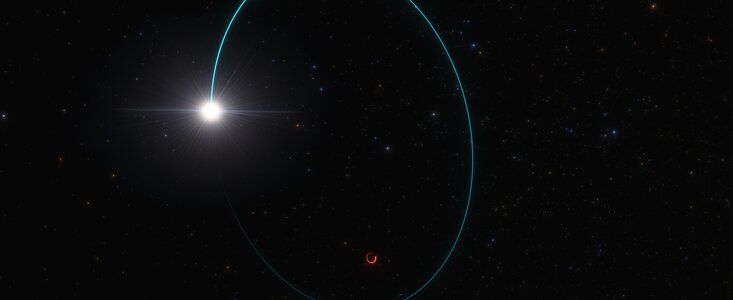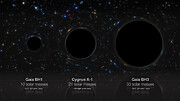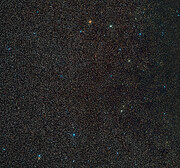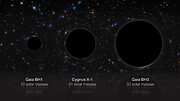Press Release
Most massive stellar black hole in our galaxy found
16 April 2024

Astronomers have identified the most massive stellar black hole yet discovered in the Milky Way galaxy. This black hole was spotted in data from the European Space Agency’s Gaia mission because it imposes an odd ‘wobbling’ motion on the companion star orbiting it. Data from the European Southern Observatory’s Very Large Telescope (ESO’s VLT) and other ground-based observatories were used to verify the mass of the black hole, putting it at an impressive 33 times that of the Sun.
Stellar black holes are formed from the collapse of massive stars and the ones previously identified in the Milky Way are on average about 10 times as massive as the Sun. Even the next most massive stellar black hole known in our galaxy, Cygnus X-1, only reaches 21 solar masses, making this new 33-solar-mass observation exceptional [1].
Remarkably, this black hole is also extremely close to us — at a mere 2000 light-years away in the constellation Aquila, it is the second-closest known black hole to Earth. Dubbed Gaia BH3 or BH3 for short, it was found while the team were reviewing Gaia observations in preparation for an upcoming data release. “No one was expecting to find a high-mass black hole lurking nearby, undetected so far,” says Gaia collaboration member Pasquale Panuzzo, an astronomer from the National Centre for Scientific Research (CNRS) at the Observatoire de Paris - PSL, France. "This is the kind of discovery you make once in your research life."
To confirm their discovery, the Gaia collaboration used data from ground-based observatories, including from the Ultraviolet and Visual Echelle Spectrograph (UVES) instrument on ESO’s VLT, located in Chile’s Atacama Desert [2]. These observations revealed key properties of the companion star, which, together with Gaia data, allowed astronomers to precisely measure the mass of BH3.
Astronomers have found similarly massive black holes outside our galaxy (using a different detection method), and have theorised that they may form from the collapse of stars with very few elements heavier than hydrogen and helium in their chemical composition. These so-called metal-poor stars are thought to lose less mass over their lifetimes and hence have more material left over to produce high-mass black holes after their death. But evidence directly linking metal-poor stars to high-mass black holes has been lacking until now.
Stars in pairs tend to have similar compositions, meaning that BH3’s companion holds important clues about the star that collapsed to form this exceptional black hole. UVES data showed that the companion was a very metal-poor star, indicating that the star that collapsed to form BH3 was also metal-poor — just as predicted.
The research study, led by Panuzzo, is published today in Astronomy & Astrophysics. “We took the exceptional step of publishing this paper based on preliminary data ahead of the forthcoming Gaia release because of the unique nature of the discovery,” says co-author Elisabetta Caffau, also a Gaia collaboration member and CNRS scientist from the Observatoire de Paris - PSL. Making the data available early will let other astronomers start studying this black hole right now, without waiting for the full data release, planned for late 2025 at the earliest.
Further observations of this system could reveal more about its history and about the black hole itself. The GRAVITY instrument on ESO’s VLT Interferometer, for example, could help astronomers find out whether this black hole is pulling in matter from its surroundings and better understand this exciting object.
Notes
[1] This is not the most massive black hole in our galaxy — that title belongs to Sagittarius A*, the supermassive black hole at the Milky Way’s centre, which has about four million times the mass of the Sun. But Gaia BH3 is the most massive black hole known in the Milky Way that formed from the collapse of a star.
[2] Aside from UVES on ESO’s VLT, the study relied on data from: the HERMES spectrograph at the Mercator Telescope operated at La Palma (Spain) by Leuven University, Belgium, in collaboration with the Observatory of the University of Geneva, Switzerland; and the SOPHIE high-precision spectrograph at the Observatoire de Haute-Provence – OSU Institut Pythéas.
More information
This research was presented in a paper entitled “Discovery of a dormant 33 solar-mass black hole in pre-release Gaia astrometry” to appear in Astronomy & Astrophysics (https://aanda.org/10.1051/0004-6361/202449763).
The paper, by P. Panuzzo et al., is authored by the Gaia collaboration, which involves over 300 authors from around the world, including Austria, Belgium, Czechia, Finland, France, Germany, Italy, Netherlands, Poland, Portugal, Spain, Sweden, Switzerland, United Kingdom, Chile and Australia.
The European Southern Observatory (ESO) enables scientists worldwide to discover the secrets of the Universe for the benefit of all. We design, build and operate world-class observatories on the ground — which astronomers use to tackle exciting questions and spread the fascination of astronomy — and promote international collaboration for astronomy. Established as an intergovernmental organisation in 1962, today ESO is supported by 16 Member States (Austria, Belgium, Czechia, Denmark, France, Finland, Germany, Ireland, Italy, the Netherlands, Poland, Portugal, Spain, Sweden, Switzerland and the United Kingdom), along with the host state of Chile and with Australia as a Strategic Partner. ESO’s headquarters and its visitor centre and planetarium, the ESO Supernova, are located close to Munich in Germany, while the Chilean Atacama Desert, a marvellous place with unique conditions to observe the sky, hosts our telescopes. ESO operates three observing sites: La Silla, Paranal and Chajnantor. At Paranal, ESO operates the Very Large Telescope and its Very Large Telescope Interferometer, as well as survey telescopes such as VISTA. Also at Paranal ESO will host and operate the Cherenkov Telescope Array South, the world’s largest and most sensitive gamma-ray observatory. Together with international partners, ESO operates ALMA on Chajnantor, a facility that observes the skies in the millimetre and submillimetre range. At Cerro Armazones, near Paranal, we are building “the world’s biggest eye on the sky” — ESO’s Extremely Large Telescope. From our offices in Santiago, Chile we support our operations in the country and engage with Chilean partners and society.
Links
- Research paper
- Photos of the VLT
- ESA news article on this research
- For journalists: subscribe to receive our releases under embargo in your language
- For scientists: got a story? Pitch your research
Contacts
Pasquale Panuzzo
Observatoire de Paris - PSL/CNRS
Paris, France
Tel: +33 1 45 07 78 42
Email: pasquale.panuzzo@observatoiredeparis.psl.eu
Elisabetta Caffau
Observatoire de Paris - PSL/CNRS
Paris, France
Tel: +33 1 45 07 78 73
Email: elisabetta.caffau@observatoiredeparis.psl.eu
Bárbara Ferreira
ESO Media Manager
Garching bei München, Germany
Tel: +49 89 3200 6670
Cell: +49 151 241 664 00
Email: press@eso.org
About the Release
| Release No.: | eso2408 |
| Name: | Gaia BH3 |
| Type: | Milky Way : Star : Evolutionary Stage : Black Hole |
| Facility: | Very Large Telescope |
| Instruments: | UVES |
| Science data: | 2024A&A...686L...2G |
Our use of Cookies
We use cookies that are essential for accessing our websites and using our services. We also use cookies to analyse, measure and improve our websites’ performance, to enable content sharing via social media and to display media content hosted on third-party platforms.
ESO Cookies Policy
The European Organisation for Astronomical Research in the Southern Hemisphere (ESO) is the pre-eminent intergovernmental science and technology organisation in astronomy. It carries out an ambitious programme focused on the design, construction and operation of powerful ground-based observing facilities for astronomy.
This Cookies Policy is intended to provide clarity by outlining the cookies used on the ESO public websites, their functions, the options you have for controlling them, and the ways you can contact us for additional details.
What are cookies?
Cookies are small pieces of data stored on your device by websites you visit. They serve various purposes, such as remembering login credentials and preferences and enhance your browsing experience.
Categories of cookies we use
Essential cookies (always active): These cookies are strictly necessary for the proper functioning of our website. Without these cookies, the website cannot operate correctly, and certain services, such as logging in or accessing secure areas, may not be available; because they are essential for the website’s operation, they cannot be disabled.
Functional Cookies: These cookies enhance your browsing experience by enabling additional features and personalization, such as remembering your preferences and settings. While not strictly necessary for the website to function, they improve usability and convenience; these cookies are only placed if you provide your consent.
Analytics cookies: These cookies collect information about how visitors interact with our website, such as which pages are visited most often and how users navigate the site. This data helps us improve website performance, optimize content, and enhance the user experience; these cookies are only placed if you provide your consent. We use the following analytics cookies.
Matomo Cookies:
This website uses Matomo (formerly Piwik), an open source software which enables the statistical analysis of website visits. Matomo uses cookies (text files) which are saved on your computer and which allow us to analyze how you use our website. The website user information generated by the cookies will only be saved on the servers of our IT Department. We use this information to analyze www.eso.org visits and to prepare reports on website activities. These data will not be disclosed to third parties.
On behalf of ESO, Matomo will use this information for the purpose of evaluating your use of the website, compiling reports on website activity and providing other services relating to website activity and internet usage.
Matomo cookies settings:
Additional Third-party cookies on ESO websites: some of our pages display content from external providers, e.g. YouTube.
Such third-party services are outside of ESO control and may, at any time, change their terms of service, use of cookies, etc.
YouTube: Some videos on the ESO website are embedded from ESO’s official YouTube channel. We have enabled YouTube’s privacy-enhanced mode, meaning that no cookies are set unless the user actively clicks on the video to play it. Additionally, in this mode, YouTube does not store any personally identifiable cookie data for embedded video playbacks. For more details, please refer to YouTube’s embedding videos information page.
Cookies can also be classified based on the following elements.
Regarding the domain, there are:
- First-party cookies, set by the website you are currently visiting. They are stored by the same domain that you are browsing and are used to enhance your experience on that site;
- Third-party cookies, set by a domain other than the one you are currently visiting.
As for their duration, cookies can be:
- Browser-session cookies, which are deleted when the user closes the browser;
- Stored cookies, which stay on the user's device for a predetermined period of time.
How to manage cookies
Cookie settings: You can modify your cookie choices for the ESO webpages at any time by clicking on the link Cookie settings at the bottom of any page.
In your browser: If you wish to delete cookies or instruct your browser to delete or block cookies by default, please visit the help pages of your browser:
Please be aware that if you delete or decline cookies, certain functionalities of our website may be not be available and your browsing experience may be affected.
You can set most browsers to prevent any cookies being placed on your device, but you may then have to manually adjust some preferences every time you visit a site/page. And some services and functionalities may not work properly at all (e.g. profile logging-in, shop check out).
Updates to the ESO Cookies Policy
The ESO Cookies Policy may be subject to future updates, which will be made available on this page.
Additional information
For any queries related to cookies, please contact: pdprATesoDOTorg.
As ESO public webpages are managed by our Department of Communication, your questions will be dealt with the support of the said Department.







